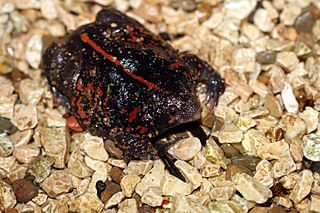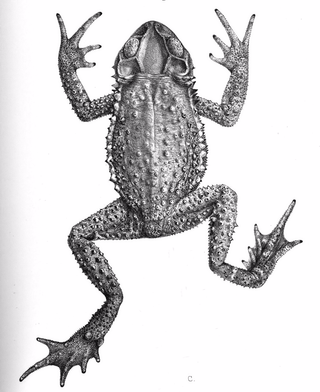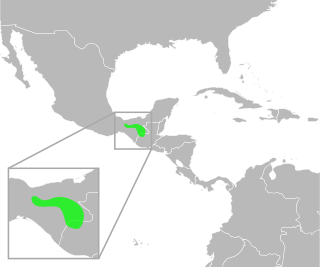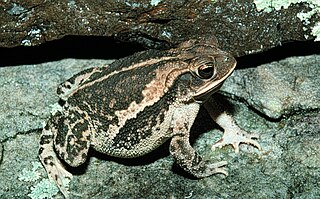
The Colorado River toad, also known as the Sonoran Desert toad, is a toad species found in northwestern Mexico and the southwestern United States. It is well known for its ability to exude toxins from glands within its skin that have psychoactive properties.

The European green toad is a species of toad found in steppes, mountainous areas, semi-deserts, urban areas and other habitats in mainland Europe, ranging from far eastern France and Denmark to the Balkans and Western Russia. As historically defined, the species ranged east through the Middle East and Central Asia to western China, Mongolia and northwestern India, and south through Italy and the Mediterranean islands to North Africa. Following genetic and morphological reviews, 14 populations are now regarded as separate species. These species and the European green toad are placed in their own genus Bufotes, but they were included in Bufo.

The Mexican burrowing toad is the single living representative of the family Rhinophrynidae. It is a unique species in its taxonomy and morphology, with special adaptations to assist them in digging burrows where they spend most of their time. These adaptations include a small pointed snout and face, keratinized structures and a lack of webbing on front limbs, and specialized tongue morphology to assist in feeding on ants and termites underground. The body is nearly equal in width and length. It is a dark brown to black color with a red-orange stripe on its back along with splotches of color on its body. The generic name Rhinophrynus means 'nose-toad', from rhino- (ῥῑνο-), the combining form of the Ancient Greek rhis and phrunē.

The American toad is a common species of toad found throughout Canada and the eastern United States. It is divided into three subspecies: the eastern American toad, the dwarf American toad and the rare Hudson Bay toad. Recent taxonomic treatments place this species in the genus Anaxyrus instead of Bufo.

The southern toad is a true toad native to the southeastern United States, from eastern Louisiana and southeastern Virginia south to Florida. It often lives in areas with sandy soils. It is nocturnal and spends the day in a burrow. Its coloring is usually brown but can be red, gray, or black. It is approximately 8 cm (3 inches) long.

Incilius cristatus, the large-crested toad, is an endangered species of true toad that is endemic to cloud forests in the central Sierra Madre Oriental in Puebla and Veracruz, Mexico. Once feared extinct, it has recently been rediscovered at two sites in Puebla where it is uncommon. The reasons for its decline are habitat loss and pollution, and there are no recent records from Veracruz.
Holdridge's toad, formerly Bufo holdridgei, is a species of toad endemic to Costa Rica. In October 2008, it was declared extinct by the International Union for Conservation of Nature in its Red List since the species had not been seen since 1987, despite years of extensive searches. However, the species was rediscovered in 2010 by a Costa Rican herpetologist and is now classified as critically endangered. It is believed that the species is most threatened by the presence of the chytrid fungus in its habitat.
The Almirante Trail toad is a species of toad endemic to Panama. It is only known from its type locality near Boquete, Chiriquí, in western Panama. Another population from Cerro Bollo that has been referred to this species was described in 2013 as a separate species, Incilius majordomus.

The Texas toad is a species of medium-sized toad that occurs in the southern United States and northern Mexico. It breeds in temporary water pools after heavy rains.

Incilius bocourti is a species of toad in the family Bufonidae. It is found in southwestern Guatemala and in Chiapas in the adjacent Mexico. Its phylogenetic position is uncertain; it might not to belong to this genus, being the sister taxon of Anaxyrus instead. It is named after Marie Firmin Bocourt, a French zoologist and artist.

Incilius ibarrai is a species of toad in the family Bufonidae. It is found in the central and southern highlands of Guatemala and adjacent Honduras. The specific name ibarrai honors Jorge Alfonso Ibarra (1921–2000), then-director of the Guatemalan National Natural History Museum.

Incilius leucomyos is a species of toad in the family Bufonidae. It was described in 2000 and is endemic to the Atlantic versant of the north-central Honduras.

Incilius luetkenii is a species of toad in the family Bufonidae. It is found in the Mesoamerica along the Pacific versant from central Costa Rica to extreme southern Chiapas, Mexico, as well as dry interior valleys of Guatemala and Honduras and San Juan River drainage in Costa Rica on the Atlantic versant. It occurs in open areas, including disturbed pasturelands in lowland dry forest, and to a lesser extent, in lowland moist and premontane moist forests. It breeds in temporary pools. It is a common species that is not facing major threats.

Incilius macrocristatus a species of toad in the family Bufonidae. It is found in Chiapas in southern Mexico and the adjacent Guatemala. Its natural habitats are cloud forests and pine-oak-Liquidambar forests. Breeding takes place in streams. It is a rare species that is threatened by habitat loss caused by agriculture and human settlement, and by water pollution.

Incilius melanochlorus, formerly Bufo melanochlorus, is a mid-sized species of toad with a crested head in the family Bufonidae. It is primarily distinguished by its very long first finger with respect to the other fingers. It is found in southern Nicaragua, in the northern Cordillera Central and on the Atlantic slopes of eastern Costa Rica, and in western Panama.

Incilius nebulifer, also known as the coastal plains toad or Gulf coast toad, is a species of toad in the family Bufonidae. It is found on the coast of Gulf of Mexico from Veracruz in Mexico to Mississippi in the United States. It was removed from the synonymy of Incilius valliceps in 2000. It occurs in a wide range of habitats, both natural and human-altered: coastal prairies, barrier beaches, towns, etc. Breeding takes place in various kinds of pools, including roadside and irrigation ditches. This widespread and common toad is not threatened.

The pine toad is a species of toad in the family Bufonidae. It is endemic to Mexico and found on the Central Mexican Plateau.

Incilius pisinnus is a species of "true" toads in the family Bufonidae. It is endemic to Mexico and known from the Tepalcatepec Valley in Michoacán. Prior to its description in 2005, it was mixed with Incilius coccifer and Incilius cycladen. The specific name pisinnus, from the Latin word for "small", refers to the comparatively small size of this species among its close relatives.

Incilius is a genus of toads in the true toad family, Bufonidae. They are sometimes known as the Central American toads or Middle American toads and are found in southern USA, Mexico, Central America, and northern Pacific South America. They are an ecologically and biogeographically diverse group of toads, including micro-endemic species such as Incilius spiculatus that are restricted to undisturbed cloud forests, and widespread lowland species such as Incilius valliceps that predominantly occur in disturbed habitats.




















